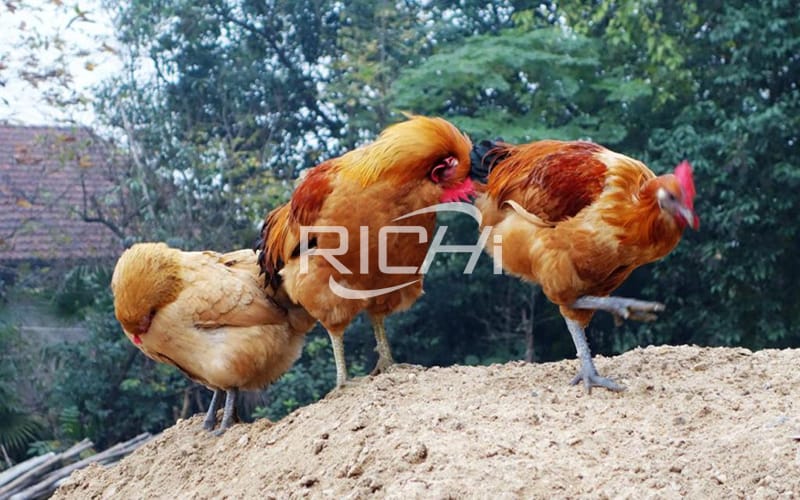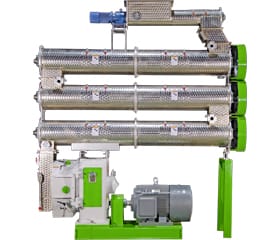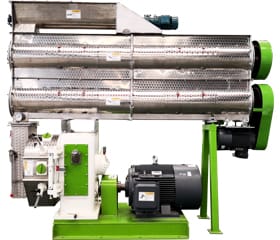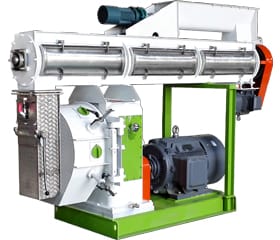Scientific management in the process of broiler breeding
The schedule and requirements of modern poultry breeding and management are becoming more and more detailed and strict, and the level of breeding management is getting higher and higher. The research on the relationship between nutrition and immunity has attracted more and more attention. World-renowned poultry disease prevention and control experts believe that: for the poultry industry, the most serious epidemic in the world is the mismanagement syndrome. More than 80% of the problems in production are not caused by pathogenic microorganisms, but by It is caused by insufficient feed nutrition, light, air, and drinking water, and this can be overcome by strengthening feeding management. Scientific management is the core of the breeding benefits. As the saying goes, one hard work makes one gain. How to manage it?

1. Temperature management
Temperature is the first factor in the survival of chickens. If the temperature is low, it is easy to get Salmonella. We require that the temperature is generally 35°C or 34°C. The chick is the first standard for testing temperature. When it is cold, it smashes, and when it is hot, it opens its mouth. It is not artificially that the temperature is appropriate or inappropriate. How to judge whether the temperature is appropriate or inappropriate? It depends on whether the chickens are evenly distributed. A uniform distribution means that the temperature is appropriate, and it is close to the furnace that the temperature is low. The distance from the stove indicates that the temperature is high. They are close to the middle of the two stoves, indicating that there is a gust of wind. The wind is more terrible than low temperature.
The poultry teaching and research group of the University of Georgia in the United Kingdom conducted an experiment. The low temperature brooding of chickens of the same breed at different temperatures of 34 ℃, 29 ℃ and 26 ℃ is three times the incidence of high temperature brooding ascites, and the mortality rate is twice. The growth difference is 30%, which is a big difference. If the temperature is lower than the normal temperature of 2℃, the difference is 500 grams. According to the current market, it is 4 quick and more money. So we do not brood the chicks at low temperature, but it is not that the higher the temperature, the better. If the temperature is too high, the chickens will easily become dehydrated. The proper temperature during brooding is conducive to the absorption of the yolk. In the first few days, the intestinal tract of the chick simply facilitates the passage of large immune molecules in the yolk. After 14 days, the intestinal permeability is closed and the maternal antibody cannot enter the body. If the egg yolk is rich in protein, amino acids, vitamins, minerals and other nutrients, if it cannot be absorbed by the body, it will be used by Salmonella to cause umbilical corditis, and then become infected with pericardial liver.
The chicken cannot control its own body temperature change in the early stage. It can only gradually complete this function after 15~21 days, so we need to give it a good temperature. Let's see how the chicken is affected by those temperatures. First of all, the temperature of the chicks from the hatcher is 37.2°C. After we have ordered the chicks, the faucet will deliver the chicks to your chicken house. This process is at room temperature. The chicken house has warmed up in advance. In this way, the chick went through the process from hot to cold to hot in a short period of time. The temperature changes too much in a short period of time, and the hot and cold stress will stimulate the large amount of adrenaline secretion in the chicks, resulting in insufficient secretion of phagocytes and the immune system will be damaged.
So, in order not to cause too much heat and cold stress, it is more appropriate to set the temperature of the chickens in the chicken house at 30℃—32℃, and then slowly adjust the temperature in the house within a few hours The standard temperature is 35°C. If the temperature change exceeds 5°C in a short period of time, the probability of renal branching is three times higher. Once the renal branch is obtained, the variegated kidney will appear, causing protein metabolism disorder and producing a large amount of urate deposition. The principle of treatment is to reduce protein first, add less essence or feed corn directly. The second is to increase the temperature by 3℃ to keep warm. The third is drainage and detoxification. The fourth is anti-virus control of secondary infections. Because the kidney spreads after 5 days, it will trigger other bacterial diseases.
35℃ is only the temperature for 1-2 days after brooding, 34.5℃ on the third day, and a decrease of 34℃ from the 4th day, 33.5℃ on the 5th day, and 33.℃ on the 6th day. After that, drop 3°C every week or 1°C every 2 days. .Having dropped to 18℃-21℃. 18 ℃ is the absolute fastest growth rate of chickens, but the meat ratio is not suitable. It is suitable to use this temperature when the feed is cheap and the chickens are expensive. But now the price of feed for Guimao chickens is not too high and they are raised at 21°C, because this is the most suitable temperature for chicken feed.
The temperature change should not be too large, 0-24 days should not exceed 2℃, 24-35 days should not exceed 4℃, 35-48 days should not exceed 6, 48---listed should not exceed 8℃.
The brooding must be 1-2°C higher at night than during the day, (people need to be covered with a quilt at night, and chickens must be heated without a quilt) 1-2°C higher than normal during immunization. All During the disease, the temperature will increase by 2℃.
2. Humidity management
Some farmers usually don’t pay attention to moisturizing, but only pay attention to temperature. The brooding room temperature is normally 35℃, and the humidity is 70%. If the temperature is high and the humidity is low, a large amount of water in the body will be lost and the chickens will become dehydrated and dry. Sunflower seeds make it easy to catch a cold after bathing
How to humidify:
(1) When the stove is raw, place a water basin on the stove to let it emit water vapor to increase the humidity. After the boiled water is allowed to cool, give the chicken a good drink.
(2) Spray water on the ground. The humidity requires 70% for 1-3 days, and it will drop to 60%-65% in 4-7 days. If it does not drop, E. coli and coccidia may break out in about 10 days. After 7 days, it drops to 55%-60%.
If the temperature is high and the humidity is low, it is like a person feels dry mouth and tongue in the morning when sleeping on a hot kang. In severe cases, there is blood in the nose. The same is true for chickens. High temperature and low humidity damage the nasal mucosa of chickens. Bacteria and viruses can easily infect the body through the damaged nasal mucosa, causing nasal throwing (attempting to throw foreign objects out of the nasal cavity); continuing to cause sneezing; the secretions of infection in the trachea are relatively thin at the beginning , Watery rales cause snoring; water absorption forms a dry-collateral-like substance that causes coughing; strange screams after infection of the mingguan cavity; asthma after bronchial embolism.
Sniffing→sneezing→snoring→coughing→wheezing, these are several manifestations of chicken respiratory infections, which are caused by high temperature and low humidity during the breeding process.
High temperature and low humidity are not conducive to the heat dissipation of chickens and easily cause heat stroke. Coccidia, enteritis and E. coli are also prone to occur. Low temperature and low humidity are easy to catch colds, diarrhea, and increase mortality. Unreasonable temperature and humidity can easily cause chickens to bathe.
3. Ventilation management:
Poor ventilation is the root cause of all diseases. Only good ventilation can ensure good air in the chicken house and chickens can grow and develop normally. And it is not easy to get respiratory diseases. This is also the reason that sick chickens can heal without medicine when they are placed outside the coop.
Attention everyone, ventilation and ventilation are not the same, many people are confused. Ventilation, the purpose is to cause the air to flow quickly to take the body temperature of the chicken out and have a cooling effect, and the wind speed is 1m/s. The purpose of ventilation is to exchange exhaust gas for oxygen, and the wind speed must not be greater than 0.2 m/s. What are the hazards of exhaust gas? Exhaust gas contains ammonia, hydrogen sulfide, carbon dioxide, carbon monoxide and so on.
(1) Ammonia → dazzling → The density is small because the above requirements of the chicken house are less than 15PPM → Otherwise, the combination of ammonia and gas management water will form ammonia water to burn the respiratory mucosa → easily cause Newcastle disease and E. coli.
(2) Hydrogen sulfide→odor→density greater than ammonia gas below ammonia gas→required less than 10PPM→otherwise hydrogen sulfide combines with sodium ions in the trachea to form sodium chloride and damage the respiratory mucosa→E.coli and mycoplasma are susceptible to infection .
(3) Carbon dioxide, carbon monoxide→density greater than air under the chicken house→less than 2500PPM→otherwise hypoxia and stuffiness→excessive hypoxia can cause ascites in chickens, and colibacillosis can occur in 2-3 days. (The method of carbon dioxide detection can use the method of striking a match. The shorter the time the match is burned in the chicken house, the more it indicates the lack of oxygen.)
(4) There are feather dust and dust in the chicken house. E. coli will break out one week after the dust exceeds the standard.
Ventilation is required to discharge harmful exhaust gas and feather dust. The best time for ventilation is when the temperature difference between inside and outside of the day is the smallest, which is 2 o'clock in the afternoon. If you want to ventilate, open all windows and vents, but be careful not to let the wind blow directly on the chicken, and do not open the windows a little bit, so that it is easy to cause wind. The wind is more terrible than the low temperature. The wind in the winter is like a sword, and the chicken that hits it will get sick. After 25 days, the chicken is mainly ventilated. If the air is well ventilated, the chickens can be raised.
4. Density management:
At the time of brooding, there are 33-40 chicks per square meter, and the density is gradually reduced as the age increases, and the standard is kept at 20 kg per square meter. Originally, our popular calculation method was to raise 8 to 10 chickens per square meter in summer and 10 to 12 chickens in winter. What will happen if the density is too high in order to raise more chickens in a fixed chicken coop? If the density is too high, the chickens will eat unevenly, resulting in some large and small chickens. It also provides conditions for the occurrence of diseases such as Escherichia coli, mycoplasma, and ascites. The density is too small and the chicken coop is wasted, the utilization rate of the chicken coop is reduced, and our input cost is increased. It is also important to arrange the number of chickens reasonably.
5. Light management:
A lot of us now have 24 hours of light, which is unreasonable. In foreign countries, light is circulated, giving 1 hour of care and immediately giving 2 hours of darkness. Allow the chickens to have a digestion time after eating the feed, and the feed utilization rate is high. There is also a little cyclic light that the chicken can adapt to the dark. If we suddenly lose power, the chicken will not be a big emergency. Otherwise, the chicken will panic, run, fly, scream, fight, etc., if we don’t adapt to the sudden darkness. Crush some chickens. Appropriate darkness is good for the chicken, and at the same time we can save some electricity bills.
What kind of light is reasonable? Let's take 1,000 chickens as an example. 1000 chickens need 8 lamp holders and 8 40-watt bulbs for the first three days, so that the chickens can be familiar with the environment of the chicken house as soon as possible and know the location and distribution of the trough. On the 4th day, 15 watt bulbs were also installed, which is also 8 bulbs. The test standard is to put the newspaper on the ground, one foot away from the newspaper, you can see the lines of the newspaper clearly without seeing the specific words. The purpose of changing to 15 watts is not to give the chickens too much light. If the light is too strong, the chickens are easy to run excitedly, etc., which is not conducive to the absorption of feed. We raise pigs and hope that the pigs will sleep when they are full. The same is true for chickens. Eat feed and exercise less.
The lamp holders should be placed in a triangular distribution as much as possible. Don't be right and left aligned. This will easily form a blind spot between the 4 lights. If there is a sink and trough here, it will affect the chickens' eating and drinking. The height of the lamp head is 1.8 meters to 2 meters, and the distance between the lamp heads is 1.5 meters, which is more reasonable.
When feeding pellets, stop the electricity for 2-3 hours when the food is good, so that the chickens feel like the beginning of a new day after turning on the light. From 10 o'clock in the evening to 4 o'clock the next day, the chicken eats very little food, mainly to let it digest the feed and rest. If there is no habit of power outage, there will be many symptoms of sudden death in the later stage of the chicken.
6. Drinking water management
Everyone will do drinking water, try to pay attention to some details. If the water temperature is higher than the temperature of the chicken house, it is easy to cause the chicks to bathe, and the humidity of the chicken house is too low to cause the chicks to bathe. We require that drinking water must be clean and adequate. Some experts have done experiments. A chicken flock with clean and adequate drinking water and a chicken flock with unclean and adequate drinking water can gain 250 grams of body weight when they are out of slaughter.
The sink should be kept clean. It is best to wash it once a day. If there is no sticky thing on the sink like snot, it is myxobacteria. If it exists for a long time, it is easy to get necrotizing enteritis.
Do not exceed 1 hour in summer when water is stopped for chickens and 3 hours in winter. In laying hens, the first day of water interruption caused a 30% drop in egg production, and the second day’s egg production rate decreased by 70%. By the third day, no eggs were laid. This also shows the importance of drinking water to chickens.
7. Feeding management
When will the chicken be fed after it comes? You should feed the chicken for the first time after 80% of the chicken can drink. The method of feeding is to take 100 chicks as an example. 1000 chickens eat 13 kilograms of feed on the first day, divided into 8 to 12 feedings. Feed every 2 to 3 hours. Let the chicks eat 80% of the feed within half an hour and eat them all within one hour. Do not feed immediately after eating, wait 2 to 3 hours before feeding. If you feed too often, there will be big crops, hard crops and soft crops. How did it happen? Those diligent farmers will fill the chickens as soon as they see that the chickens are out of feed. For those strong chickens, you will feed them once and they will eat them once. The continuous eating all day causes indigestion.
After the chick had eaten it, the next day there was not much food dangling around the trough. Once you touched it, the crop was so big that you thought it was full and you didn’t care about it. On the third day, the chick closed his eyes and dangled. When he touched it again, the crop became hard. On the fourth day, the chick's spirits were even worse. The crop became soft, and the sour and smelly liquid would flow out from the corner of the mouth when the chick was picked up and upside down. In this way, we have grown some very good and healthy chicks into weak chicks.
【Related info about broiler chicken】
1.3tph broiler chicken feed making machine for sale
2.large broiler chicken feed equipment for sale in south africa
3.How to start a broiler chicken feed plant?
4.how to make chicken feed pellets for broilers?
5.1-10 ton per hour broiler chicken feed factory price
6.small broiler chicken feed machine prices for Bangladsesh market
7.5t/h automatic ring die ce chicken feed broiler making machine for poultry feed
8.How to build a high-quality broiler chicken and pig combined feed pellet production line?
9.Two formulas of 0.2% trace elements in broiler feed
10.Quality control of poultry broiler feed and its raw materials
If you want to built one complete pellet production line in your country, pls send the inquiry to us. We will customized design according to your requirement.



